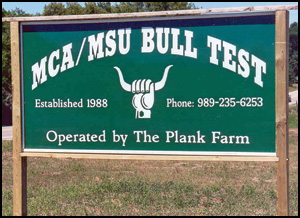HEALTH & NUTRITION...

Means to an End
While health requirements at Michigan’s bull test station may not be necessarily unique, the partnerships fostered to keep those requirements tough and contemporary may be. Interested parties in Michigan have found that by working proactively together on health and other crucial quality issues, they can reduce problems with bulls, add more value to their sales and prompt producers in the state to improve their own operation protocols.
“We have 30-plus operations that commingle cattle at the station, and that requires a rigid health protocol,” says Monte Bordner, Angus representative and chair for the Michigan Cattlemen’s Association/Michigan State University (MCA/MSU) Bull Test from Sturgis, Mich. “It has become second nature. All of us work together to bring the health requirements up, and that raises the bar for everyone. We believe the health requirements add value to the bulls we sell. It is a little like offering a warranty on a car.” Read more.
Maximum Reproductive Performance,
Minimum Feed
Maintaining and feeding beef cows to attain a body condition score (BCS) in the optimum moderate range (BCS 5-7 on a 9-point scale) allows beef cows to achieve maximum reproductive performance while holding feed supplementation costs to a minimum, according to the Virginia Cooperative Extension.
In most situations, it is not economically feasible to supplement the entire herd if only half of the cows will respond to the higher level of nutrition. Separating cows based on BCS and feeding them accordingly are good managerial strategies. This should be done at or soon after weaning to allow two to five months of feeding prior to calving. Read more.
Distillers’ Grains for Cows: Boon or Bust
The ethanol industry in the U.S., especially in Iowa, has increased dramatically, resulting in the annual production of millions of tons of coproducts. Every bushel of corn processed for ethanol produces about 2.8 gallons of ethanol and 17-18 pounds of distillers’ grains (DGs) on a dry basis. Large quantities of DGs are expected to be available to the livestock industry for many years, but changes in manufacturing techniques change the nutrient content and density of the feedstuff.
Are DGs a boon or bust for the cow herd? Iowa State University Extension Beef Specialist Daryl Strohbehn shares an Iowa perspective, covering the variety of coproducts available, nutrient values, challenges, feeding and management considerations, storage, and cost opportunities. Read more.

Bob Larson
Vet Link
Neosporosis and leptosporosis
In the May EXTRA, I wrote about two viruses that can cause abortions in cattle — infectious bovine rhinotracheitis (IBR) and bovine viral diarrhea (BVD). This month I want to write about two other causes of abortions — neosporosis and leptospirosis. Read more.
Information, Prevention Essential in Stopping FMD
Early detection of foot-and-mouth disease (FMD) and immediate and effective intervention by veterinary authorities and the agricultural industry is essential in controlling or eradicating the disease, according to a new publication released by the International Dairy Federation (IDF).
The position paper, which can be ordered at www.fil-idf.org on the Publications page, outlines the effects of an FMD epidemic and offers guidance. Focused mostly toward the dairy industry, the report does promote the use of a contingency plan for managing an FMD outbreak on the national, local and farm levels.
Ridin’ Herd
What does a feed tag tell you?
There is a lot of information on a feed tag. This article will review information that is on a feed tag and then address some of the more frequently asked questions producers have in regard to the information. Read more.
Beware of Grass Tetany, Pasture Bloat
Beef producers should expand their knowledge about grass tetany and bloat to protect their cows, a Purdue University expert says.
Ron Lemenager, Purdue Extension beef nutrition specialist, says it is important to manage herds to prevent grass tetany and bloat. Cows in early lactation are the most susceptible, with older cows considered more susceptible than those with their first or second calves. Read more.
Cattle Diseases: Common Conditions/Terms
Click here for a list of common conditions and terms related to beef cattle diseases, such as anaplasmosis, brucellosis, BVD, E. coli, IBR and others.





